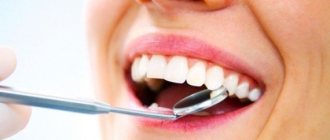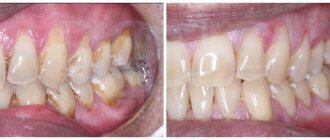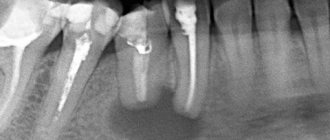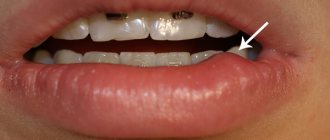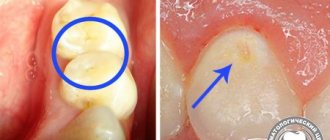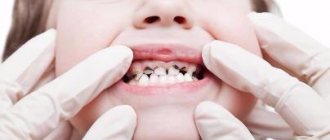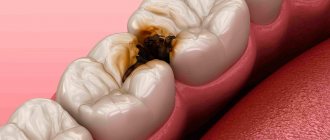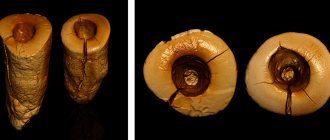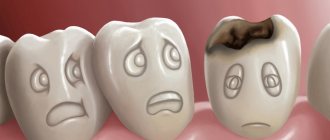- Revolutionary Icon Method
- How dentists treat caries with the Icon system
- Indications for Icon (Icon)
- Features of the technique
- Advantages of the system
- Results of using the Icon system
- What is special about Icon material?
- Forget about fears of the drill
- When a drill is not required
- Cost of treatment using the Icon method
- Stages of treatment using the Icon method
- Advantages of the method in the treatment of initial caries in children
- Reviews
Caries begins with a white spot, which gradually progresses, forming a cavity in the tooth, spreading into the deep tissues.
The initial stage of caries is perfectly treated using the Icon microinvasive technique. The presence of a white spot is explained by the fact that the tooth has begun to lose minerals from the enamel. This loss can be restored through remineralization therapy. But not all drugs are equally effective. Infiltration therapy of the initial stage of caries using the Icon method in the early stages not only stops the process, but also restores the tooth, providing good aesthetics. The Icon technique is indicated for patients with caries, when tissue damage manifests itself only in the presence of a spot. Under the influence of caries, enamel changes its texture and color, the shine in the affected area disappears, the surface feels rough to the touch, with a whitish tint. These stains also have another name - “coated”. The patient most often does not notice such spots. Therefore, preventive visits to the dentist on a regular basis allow you to notice the pathological process in time. The stain stage does not require tissue preparation using a drill.
What is the Icon treatment?
Since Soviet times, well-known methods of remineralization and preparation today are gradually being replaced by new technologies that are much more reliable and allow for more gentle treatment.
Infiltration of affected tissue using Icon technology acts as a more modern method alternative to filling. When using it, no preparation is performed. With the timely use of this treatment method, when the disease has only affected the tooth, its complete cure is guaranteed in 99% of cases. In this case, one visit to the doctor is enough.
Dentists' opinions
Dentists have an ambivalent attitude towards infiltration treatment.
Some believe that this procedure is effective and necessary in modern dentistry. Other experts consider it an ineffective and unnecessary technique, remaining adherents of classical methods of treatment.
Pediatric dentists have a special relationship with Icon technology, arguing for its effectiveness, ease of use, and the absence of any pain in children.
In addition, the gentle method will allow children in the future not to feel afraid of visiting the dentist’s office.
In the video, a specialist answers frequently asked questions regarding Icon dental treatment technology.
How did Icon technology come about?
Icon, short for Infiltration Concept, which means “infiltration concept”. This technology was developed by the German company DMG, then it began to be widely used in European countries, and today it is already gaining popularity in Russia.
This treatment is minimally invasive and very popular in modern medicine, as it involves minimal interference in the natural functioning of the human body.
This technique works by introducing a polymer composition into the area affected by caries. The main objective of this treatment technology is to seal the affected cavity and stop the proliferation of pathogenic bacteria. At the same time, Icon helps restore the previous density of dental tissue and makes it much more resistant to acids in the future. Infiltration is an innovative method in dentistry.
This procedure is indicated for the early stages of caries development, when it appears as a white or dark spot on the enamel. That is, when there is no carious cavity on the surface yet.
It is especially convenient to use this technique when caries affects places that are difficult to reach. It is difficult to clean the spaces between teeth with a drill, but with the help of Icon, you can easily carry out treatment, since the device has very thin applicators.
Icon is often used to treat dark spots after braces are removed. Thus, caries is stopped at its early stage, protecting the beauty of the patient’s smile. In this case, tooth enamel does not crack, its color and transparency are preserved.
Alternatives
Until recently, there were only two ways to treat early caries - prevention through fluoride treatment and an invasive technique involving preparation and restoration of the affected tissue.
Undoubtedly, one of the analogues is classical preparation with filling with a composite material (installation of a filling), which involves the use of a drill.
There are also more modern methods, which, unfortunately, are not relevant in all cases.
For example, remineralization is carried out at the initial stages of disease development. This method involves restoring the mineral composition of the protective layer and removing deposits . This technique helps to compact the enamel and enhances its resistance to carious lesions .
There is also an ART method, where instead of a drill, excavators are used, which literally “scrape off” tissue affected by caries . Afterwards, the cavity is filled with glass ionomer cement, which releases fluoride into the tissue, thereby preventing the development of caries.
Interaction with other substances
- This material cannot be used with substances that inhibit polymerization.
- Particularly with materials containing eugenol, such as temporary cements.
Peculiarities
Infiltration using the Icon method has the following features:
- Its use gives positive results in the early and middle stages of the disease, until it progresses to a deep stage. Deep caries cannot be cured by this method; for such a disease, it is advisable to perform a filling using the classical method.
- Icon strengthens tooth tissues and promotes their future resistance to the effects of acids. With this method of treatment, the layer of the tooth affected by caries is also removed by burning, but it is much less than when using a drill. Also, the new technology resists cracks in the enamel, which remains hard after the procedure.
- Icon cannot always stop tooth decay. In some cases it may return. In this case, restoration of the dental organ and its treatment using the classical method are used. But such cases are very rare. At the same time, it is important to understand that the patient will not lose anything special, since, without using the Icon, he would still have to use a drill.
Forecast
Most patients note a positive result of treatment.
However, this does not mean that the technology is a miracle of medicine and will save in all cases. The deeper the carious lesion, the worse the result. This is due to the fact that during the etching process, not all dentin layers are reached.
Thus, if you already have an average degree of caries damage, you should not expect a Hollywood smile from the procedure, so as not to be disappointed with the result.
Application of technology
For many patients, the great news is that anesthesia is not used during treatment using Icon technology, since it is not necessary. This is especially noteworthy for patients who are allergic to pain medications.
This method of caries treatment is based on the porous structure of the affected enamel, which resembles scale on the surface of the tooth. It is treated with a special compound, and then a sealant is applied, which quickly saturates the dental tissue, and when polymerized, it forms a reliable structure.
This treatment helps the tooth acquire strength and resistance to external influences. Lost color and transparency are also restored, which significantly improves the aesthetic appearance.
Note: This procedure is very popular when used after removing braces, as well as among patients who do not take good care of their oral hygiene.
When carrying out treatment, it is important to follow the following steps:
- The tooth must be isolated from its neighbors.
- To open the pores on the affected surface, it is coated with a special gel.
- The cavity is dried.
- The affected area is filled with infiltrant. This is often done in two stages with a three-minute break.
- The surface is hardened using a special lamp.
- The surface of the tooth is polished.
Treatment occurs quite quickly. It takes no more than 40 minutes.
Should I use Icon?
Thanks to new developments in dentistry, treatments are improving more and more rapidly, and the drill will sooner or later be replaced by an alternative method of treating caries.
The Icon method has only been used in Russia for six years. For this reason, Russian specialists do not yet have much experience in its use. At the same time, the cost of the procedure exceeds the price of the classical method of caries treatment. And only certain categories of people who take the most careful care of their teeth can use it.
In addition, numerous surveys of dentists have shown that most patients come to treat medium and deep caries, and the initial stage is rarely treated.
But still, a patient who has been diagnosed with early caries should see a dentist who knows the Icon technique. And if your doctor recommends using it, you shouldn’t refuse. After all, with this method, healthy tooth tissue is preserved, and the effect on it is more gentle, compared to classical treatment. At the same time, the patient will always have time to drill the tooth if necessary.
Icon's popularity is gradually growing. It is gradually being introduced not only into expensive, but also into clinics for the middle class. Therefore, it is worth trying out the effects of new developments for yourself.
Causes of caries of primary and permanent teeth in children
- Poor oral hygiene. Children rarely like to brush their teeth, so parents should ensure quality care twice a day, rinsing their mouth after meals.
- Imbalance in the menu. It is necessary to include solid vegetables and fruits in the child’s diet, and minimize the amount of sweet and carbohydrate foods.
- Transmission of infection from parents. Adults should not kiss a child on the lips or lick baby spoons or pacifiers.
- Hereditary factor. Dental health is genetic, so parents can assess risks based on the frequency of their dental appointments.
Advantages and disadvantages
Like any other type of treatment, Icon has both pros and cons. Let's consider both.
Advantages:
- Minor tooth decay can be treated without preparing it.
- Short duration of treatment, approximately 20-25 minutes.
- No anesthesia or drill is used. The procedure is absolutely painless.
- Healthy tissues of the dental organ are not loaded, as happens with classical treatment.
- The area treated with this method is completely invisible against the background of other organs of the oral cavity.
Flaws:
- such treatment gives results only in cases of superficial tissue damage; it does not treat deep caries; it requires the tooth to be prepared and filled;
- the cost is significantly higher compared to classical treatment. This procedure will cost approximately 3.5-4 thousand rubles. And in economy class dentistry it is perhaps a little cheaper;
- Only a highly qualified and advanced specialist in the field of new technologies can carry out such treatment efficiently;
- To date, there is no consensus among experts regarding such treatment. There are both its supporters and opponents;
- With this technique, a thin layer of the tooth still evaporates, although it is much smaller than when using a drill. At the same time, it is not always possible to stop caries, and the patient must subsequently resort to drilling.
Stages of treatment using the Icon method
The Ikon procedure has several stages. Let's look at it step by step:
- First, the tooth must be thoroughly cleaned of stone and plaque, and also polished.
- The tooth surface for infiltration must be completely dry. Therefore, the affected dental organ is isolated from the oral cavity using a special latex plate (cofferdam).
- Next, the teeth need to be moved away from each other. For this purpose, special wedges are used. Wedging is not particularly pleasant, but quite tolerable.
- The tooth is then prepared for infiltration. A special gel is applied to it, which is left for a couple of minutes so that the tooth is etched and the porous part of the initial caries becomes accessible to the specialist.
- Next, the gel is removed, and the tooth surface is dried again.
- Then a tip is put on the Icon-Dry, with which one special polymer is first applied to the tooth (for half a minute), then, after drying, another infiltrate is applied (for 3 minutes).
- At the last stage, a supercomposite material is applied, which is then polymerized for 40 seconds using a special lamp.
The dentist may invite the patient for a follow-up appointment after the procedure, a few days later. Thus, he can monitor the condition of the treated organ.
The formulations used in the Icon treatment are highly penetrating. For this reason, tooth tissues become saturated very quickly. At the same time, even microcapillaries are sealed against the penetration of harmful bacteria. So, caries stops.
This technology is also good because there are no changes in the anatomical structure of the tooth. The drill is not used, which means healthy tissue is not affected.
With this treatment, the patient receives only positive emotions.
According to experts, this type of treatment is very simple. Three different drugs are sequentially applied to the tooth. And the results in most cases are excellent.
Recommendations for use
Treatment of proximal surfaces with Icon Kariesinfiltrant – approximal
- Before treatment, clean the tooth being treated and adjacent teeth. After cleaning, remove all residues with a water jet. Apply rubber dam.
- Insert one of the supplied spacer wedges into the space between the teeth. In order for the wedge to better enter the proximal part, its handle can be rotated at an angle. — For the necessary separation of the teeth, the wedges must be inserted to a sufficient depth of the interdental space. – To ensure successful treatment, the teeth must be separated by approx. at 50 µm. This can be done in stages: insert the wedge until you feel resistance. Wait 3-5 seconds, then gradually insert the wedge deeper until the widest part of the wedge sufficiently separates the teeth. — Leave the separating wedge in the proximal space throughout the procedure.
- Screw the proximal tip onto the Etch syringe and insert the tip into the interdental space. In this case, the green side of the proximal nozzle should be directed towards the surface being treated. — The material comes out only from the green side of the film. Carefully! Improper use of Etch may cause pain to the patient. — Icon-Etch should only be used on enamel. Do not use on exposed dentin or filled areas.
- Apply Etch with a small excess to the affected area. 1.5 - 2 turns of the piston approximately correspond to the required amount of material. Leave Etch on for 2 minutes. If necessary, remove large excess material. — The syringe is controlled with one hand.
- Remove the application film from the interdental space. Suction off the Etch and rinse with water for at least 30 seconds. Then dry with dry air from an oil-free compressor.
- Screw the tip (needle) onto the Dry syringe, apply the material with a slight excess to the affected area and leave to act for 30 seconds. Then dry with dry air from an oil-free compressor. — Do not apply Icon-Infiltrant under direct light from a dental light as this may cause premature polymerization of the material.
- Screw the new proximal tip onto the Icon-Infiltrant syringe and insert the tip into the interdental space. In this case, the green side of the proximal nozzle should be directed towards the surface being treated. — The material exits only from the green side of the proximal nozzle.
- Apply Icon-Infiltrant with a slight excess to the affected area. 1.5 - 2 turns of the piston approximately correspond to the required amount of material.
- Leave Icon-Infiltrant to act for 3 minutes, adding material if necessary.
- Remove the attachment from the interdental space. Remove excess material using dental floss.
- Illuminate Icon-Infiltrant from all directions for at least 40 seconds.
- Screw the new proximal tip onto the Icon-Infiltrant syringe and apply the material a second time (steps 7-8) and leave for 1 minute. Remove the attachment from the interdental space. Remove excess material using dental floss. Then illuminate the material from all sides for at least 40 seconds.
- If the next affected area is treated during the same treatment session, repeat steps 1 to 12.
- Remove the separating wedge and rubber dam. Surface polishing is carried out using strips.
Treatment of vestibular surfaces with Icon Kariesinfiltrant – vestibular
- Before treatment, clean the tooth being treated and adjacent teeth. After cleaning, remove all residues with a water jet. Apply rubber dam.
- Screw the smooth surface attachment onto the Etch syringe. Carefully! Improper use of Etch may cause pain to the patient. — Icon-Etch should only be used on enamel. Do not use on exposed dentin or filled areas.
- By turning the plunger, carefully apply Icon-Etch with a slight excess to the affected area and leave to work for 2 minutes. If necessary, remove large excess material with a cotton swab. — The syringe is controlled with one hand. Note: If treatment of white spots is carried out later than 1-2 months after removal of braces, etching should be carried out twice. If the white spot is still visible after applying Icon-Dry, a third etching is recommended.
- Remove by aspirating Etch and rinse with water for at least 30 seconds. Then dry with air from an oil-free compressor.
- Screw the tip (needle) onto the Icon-Dry syringe, apply the material with a slight excess to the affected area and leave to act for 30 seconds. Then dry with dry air from an oil-free compressor. Note: When Icon-Dry is wetted, the whitish-matt color of the enamel will become less pronounced. If this does not happen, the etching process should be repeated a second and third time (two minutes each) and the surface of the teeth should be rinsed and dried again (step 3-5).
- Screw the new vestibular attachment onto the Icon-Infiltrant syringe. — Do not apply Icon-Infiltrant under direct light from a dental light as this may cause premature polymerization of the material.
- Rotate the plunger and apply Icon-Infiltrant in a slight excess to the etched surface.
- Leave Icon-Infiltrant to act for 3 minutes. Remove excess material with a cotton swab and, if necessary, dental floss.
- Illuminate Icon-Infiltrant for at least 40 seconds.
- Screw a new vestibular attachment onto the Icon-Infiltrant syringe, apply the material a second time (steps 7-8) and leave for 1 minute. Remove excess material with a cotton swab and, if necessary, dental floss. Then shine for at least 40 seconds.
- Remove rubber dam. Surface polishing is carried out using, for example, strips.
This is interesting: Plaque on teeth - what to do and how to remove: removal at home and at the dentist
Treatment of hard-to-reach places
The most common cases of caries formation are between teeth. Cleaning the interdental spaces, especially where the teeth fit tightly together, is very difficult or completely impossible. This is how caries forms. And it is not always possible to notice it in such places. Often this can only be done using x-rays.
It is better not to drill into hard-to-reach places, thereby damaging healthy tissue, but to apply special preparations to the affected area using a thin applicator.
Using Icon, you can easily saturate dental tissue with it. In this case, there will be no need to drill the tooth, or the procedure will be significantly delayed. The spot, which indicates initial caries, is first dried and then impregnated with a preparation that is a kind of resin. The procedure takes about twenty minutes, and the patient does not feel pain.
According to statistics, in 80% of cases when this treatment method is used, dental filling can be eliminated within several years.
The details of how this technology works can be described using the following example. If you take a piece of white sugar and touch it with a dark felt-tip pen, it will gradually become saturated and colored. It's the same with teeth. The area affected by caries, like sugar, absorbs monobond, which has no color (it plays the role of a felt-tip pen). Once in the dental tissue, it hardens, preventing the development of caries. And infiltration helps the stain disappear or acquire a natural appearance, completely merging with the rest of the tooth.
Price
Icon caries treatment, like all new treatment methods, has a high price due to the use of expensive materials and equipment.
In order to treat one tooth in this way, you will need from 2000 to 6000 rubles, depending on the amount of work and the clinic.
The cost also depends on the qualifications of the doctor who will perform the procedure. If you are willing to spend a large amount, and at the same time not experience pain and discomfort, as happens when using boron, it is recommended to use the Ikon method.
Reviews
Anastasia, 35 years old
I cured two teeth with Icon. At first I was embarrassed because the dark spots were a little visible, but after 10 days everything went away. The procedure is certainly not cheap, but it is worth it.
Valentina, 32 years old
I treated several teeth at once in this way. I didn’t like the fact that the former spots did not completely disappear and left behind small dots. It took about the same amount of time as with a regular filling. I don't see anything special. The procedure is best for children who are very afraid of the drill.
Alexey, 40 years old
The doctor advised to cure initial caries on the front tooth with the help of Icon, he promised a lot of “goodies”. I agreed. In principle, I am pleased with the result. It's just too expensive.
Evgeniya, 33 years old
And I was advised not to treat caries in the spot stage with Icon. Either the doctors at the clinic where I went are not very versed in this technique, or it really wasn’t suitable in my case. Instead, they carried out ultrasound cleaning and fluoridation, and gave recommendations on careful oral hygiene. They also said that someday they would still have to put a filling on this tooth.
